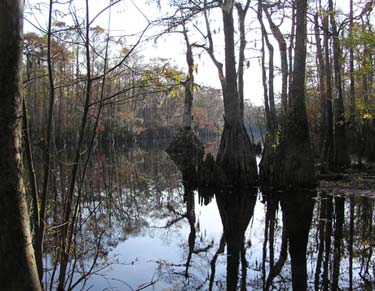Wetlands

Wetlands, including swamps, marshes, and bogs, are areas of land that are saturated with moisture seasonally or permanently. Believed to be the most diverse ecosystems in the world, wetlands are home to various species of plants, amphibians, reptiles, birds and mammals. This includes many threatened and endangered species.
In addition to wildlife habitat, wetlands act as filters to improve water quality by removing sediments and chemicals. Further, wetlands reduce flooding and recharge ground water.
Due to the lack of understanding of the value of wetlands, more than half of the wetlands in the United States have been drained or filled for development and farming. Over the last 25 years many federal and state agencies have begun research to expand this knowledge and to protect the remaining wetlands. Today research continues for one of five reasons:
- Ownership,
- Public trust responsibilities,
- Regulatory responsibilities,
- Interstate commerce, or
- International treaties.
 Much of this research centers on:
Much of this research centers on:
- Wetland processes,
- Wetland functions,
- Human-induces stresses on the ecosystem,
- Delineation and identification, and
- Management.
Some of the wetland types that occur in South Carolina include:
- Carolina bays and pocosins,
- bogs and seeps,
- pine flatwoods,
- savannahs,
- swamp forests, and
- bottomland hardwoods.
Currently there is no South Carolina state specific program for regulating wetlands. Much of the regulation is dependent on various federal programs in conjunction with the Clean Water Act.
SCDNR Managed Wetlands
- Bear Island Wildlife Management Area
- Bennett's Bay Heritage Preserve
- Botany Bay Plantation Wildlife Management Area
- Congaree Bluffs Heritage Preserve
- Congaree Creek Heritage Preserve
- Ditch Pond Heritage Preserve
- Donnelley Wildlife Managment Area
- Dungannon Plantation Heritage Preserve
- Henderson Heritage Preserve
- Hickory Top Wildlife Management Area
- Lewis Ocean Bay Heritage Preserve
- Little Pee Dee State Park Bay Heritage Preserve
- Little Pee Dee River Heritage Preserve
- Potato Creek Hatchery Waterfowl Management Area
- Samworth Wildlife Management Area
- Santee Coastal Reserve Wildlife Management Area
- Santee Delta Wildlife Management Area
- Savage Bay Heritage Preserve
- Tom Yawkey Wildlife Center Heritage Preserve
- Woods Bay Heritage Preserve
